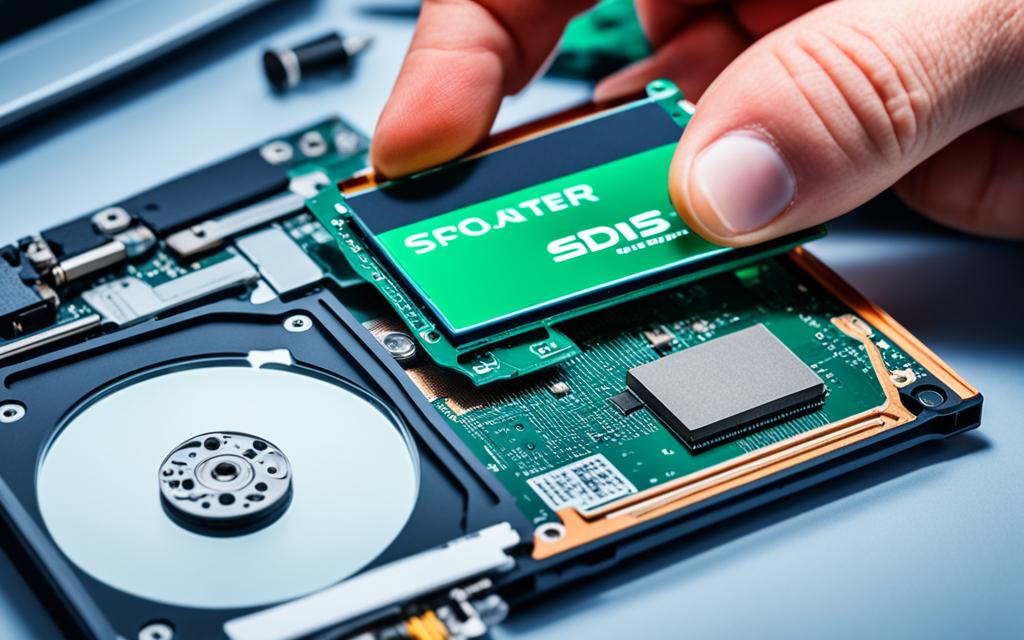Table of Contents
Solid-State Drives (SSDs) are key for keeping data today because they’re fast and reliable. Yet, losing data on them can happen. When this occurs, finding out how to get back data from an SSD is crucial. As we depend more on SSDs, the need for skilled solutions to get data back grows. This guide covers why data might get lost, like system crashes, bugs, or when you delete files by accident.
It also looks at how to fix these issues. You’ll learn about software you can use and when to call in experts. This information is for everyone, no matter your experience level. With the tips here, you’ll know what to do if your SSD data disappears1.
Key Takeaways
- Understanding SSDs is essential for effective data recovery.
- Common causes of data loss include hardware failures and accidental deletion.
- Professional data recovery options can be costly but necessary in severe cases.
- Employing data recovery software is a practical first step in attempting recovery.
- Backing up data regularly can help mitigate the impacts of data loss.
- Researching recovery solutions specific to SSDs is crucial for success.
Understanding SSDs and their Importance
Knowing what an SSD definition means is key for those seeking storage that’s both fast and trustworthy. Solid-State Drives (SSDs) are a big leap forward from the old hard disk drives (HDDs). They offer benefits that boost both performance and how we use our devices. It’s important to learn about their features and how they can be used as more people start using SSDs.
What is an SSD?
An SSD stores data using flash memory, making it much faster than old HDDs. This speed makes opening large files quick and improves your computer’s overall speed. SSDs don’t have spinning disks like HDDs, so they start up faster and can take more bumps and heat. This makes them great for things like laptops and game consoles such as PS5 and Xbox Series X2.
Benefits of SSDs over HDDs
SSDs use less power than HDDs, which means your laptop battery lasts longer. They are also silent since they don’t have any moving parts that make noise. However, SSDs can be pricier than HDDs, something shoppers should think about2.
Common Uses of SSDs in Modern Devices
SSDs are used in a wide range of tech, from powerful desktops to gadgets we carry around. You’ll find them in smartphones, tablets, and gaming systems where quick speed and storage matter a lot. Knowing where SSDs can be used helps people make smart choices when buying or upgrading their tech3.
| Criteria | SSDs | HDDs |
|---|---|---|
| Speed | Faster read/write speeds | Slower access due to moving parts |
| Durability | More shock-resistant | Vulnerable to drops |
| Energy Consumption | Lower | Higher |
| Noise Level | Quiet operation | Audible noise during operation |
| Cost | Higher | Lower |
Causes of Data Loss in SSDs
Data loss in SSDs can come from various sources. Knowing these causes helps in handling data well. It also aids in figuring out how to get lost data back.
Hardware Failures
SSD hardware problems might happen due to parts not working or damage. Heat, especially, can make SSDs stop working when used for things like AI or 3D pictures4. Overusing the SSD, making mistakes when making it, and issues with the controller can also create bad data blocks4. If your SSD starts crashing when you turn on your computer, you should back up your data right away to prevent losing it all5.
Software Corruptions
Software issues are also a big cause of data loss. They can happen if the software is used wrong or if there’s damage to the firmware. File system errors might show up if the computer is not shut down properly. You can often fix these by using a repair tool4. Keeping your firmware up to date and checking your SSD’s health can lower the risk of these problems4.
Accidental Deletion and User Errors
Human mistakes play a huge role in losing data. Losing files by accident, formatting without meaning to, or power spikes can create big headaches5. It’s very important to notice when an SSD starts to fail, like if it takes ages to read files or has problems starting. This helps in starting to fix the problems quickly5.
How to Recover Data from an SSD Drive
Lost data from an SSD drive can be retrieved using different methods. Knowing these methods helps people smartly tackle data loss when it happens.
Using Data Recovery Software
One simple way to get data back is by using special software. Tools like MiniTool Power Data Recovery are great for this. They help find lost photos, videos, and documents6. This software doesn’t change your original files, keeping them safe. It works well with Windows 7 to 11, helping many users6.
Connecting SSD to Another Computer
Another option is to plug the SSD into a working computer. This lets you try to get your files back without extra tools. Moving quickly is key. Doing this fast increases the chances of getting your data back, especially before the TRIM command clears it7.
Professional Data Recovery Services
If DIY methods don’t work, it’s time to call in the pros. Data recovery experts use sophisticated methods to retrieve lost data. They often succeed 92% to 99% of the time, especially if TRIM hasn’t run7. Trusting pros with your SSD is the best bet for getting your data back.
Steps to Perform Data Recovery Safely
When you lose data, it’s crucial to have a plan. First, check your SSD to find out why it failed. This step is key to choosing how to get your data back. Issues often come from mistakes or software problems, which are common reasons for data loss on SSDs8. By understanding the problem, you increase your chances of getting your data back.
Initial Assessment of the SSD
After figuring out the problem, get the right tools for the job. You might need special software like Tenorshare 4DDiG, or other tools, found at using reliable tools. Remember, the TRIM feature in SSDs can make recovery tough if you’re not careful9. Handling your SSD correctly to avoid more damage is very important during this stage9.
Backing Up Your Data After Recovery
Once you’ve got your data back, make sure this doesn’t happen again. Use cloud storage or an external drive for safety. This way, your files are safe and easy to access anytime. By doing this, you protect your important information for the long term.
FAQ
What is the best way to recover data from an SSD?
The best method to get back lost data from an SSD is to use special software. Programs like EaseUS Data Recovery Wizard or iolo’s Search and Recover™ are great choices. They can find and bring back deleted files efficiently. If these don’t work, professional services can help with more advanced recovery methods.
Can data be recovered from a physically damaged SSD?
Yes, it’s often possible to get data back from a damaged SSD. The success rate depends on how badly it’s damaged. Experts in data recovery have the right tools and know-how to tackle tough situations. To avoid making things worse, it’s best not to try fixing the SSD on your own.
How can I prevent data loss on my SSD?
To keep your SSD data safe, regularly back up your files to the cloud or an external drive. Ensure your system’s software is up-to-date and scan for viruses often. Being proactive in these ways helps shield your data from unexpected problems.
Are SSD data recovery services expensive?
The price of recovering data from an SSD varies. It depends on the recovery’s complexity and how much work is needed. Although it can be pricey, the value of retrieving crucial data often outweighs the cost. Comparing quotes from different providers helps find a service within your budget.
Is it safe to use DIY data recovery software?
DIY data recovery software is mostly safe when used correctly. But, be careful with significantly damaged SSDs. Accidentally writing new data over the old can make data loss permanent. When unsure, it’s wise to seek a professional’s advice for a secure recovery process.
Why is regular backup crucial for SSD users?
Backing up your SSD regularly is key because it guards against data loss risks. Risess like hardware crashes, software bugs, and user mistakes can’t touch your data. With current backups, retrieving your files is a breeze, avoiding the hassle of data recovery from damaged storage.
Source Links
- https://www.easeus.com/storage-media-recovery/recover-data-from-crashed-ssd.html – Recover Data from Dead, Failed or Crashed SSD in Windows 11/10
- https://www.n-able.com/blog/ssd-data-recovery-best-practices – Data Recovery from SSD Drives: What You Need to Know – N-able
- https://www.techtarget.com/searchstorage/definition/SSD-solid-state-drive – What is an SSD (Solid-State Drive)?
- https://www.techtarget.com/searchstorage/tip/4-causes-of-SSD-failure-and-how-to-deal-with-them – 7 causes of SSD failure and how to deal with them | TechTarget
- https://www.stellarinfo.co.in/kb/data-loss-risks-associated-with-ssd-drives.php – What are the Data Loss Risks Associated With SSD Drives?
- https://www.minitool.com/data-recovery/ssd-data-recovery.html – How to Perform SSD Data Recovery | 100% Secure
- https://www.diskinternals.com/partition-recovery/recover-data-ssd/ – How to Recover Data from an SSD Drive on Windows
- https://www.cleverfiles.com/howto/ssd-data-recovery.html – Data Recovery from SSD Drives: All You Need to Know
- https://4ddig.tenorshare.com/hard-drive/how-to-recover-data-from-ssd.html – 2024 The New Ways to Recover Data from SSD in Windows and Mac








